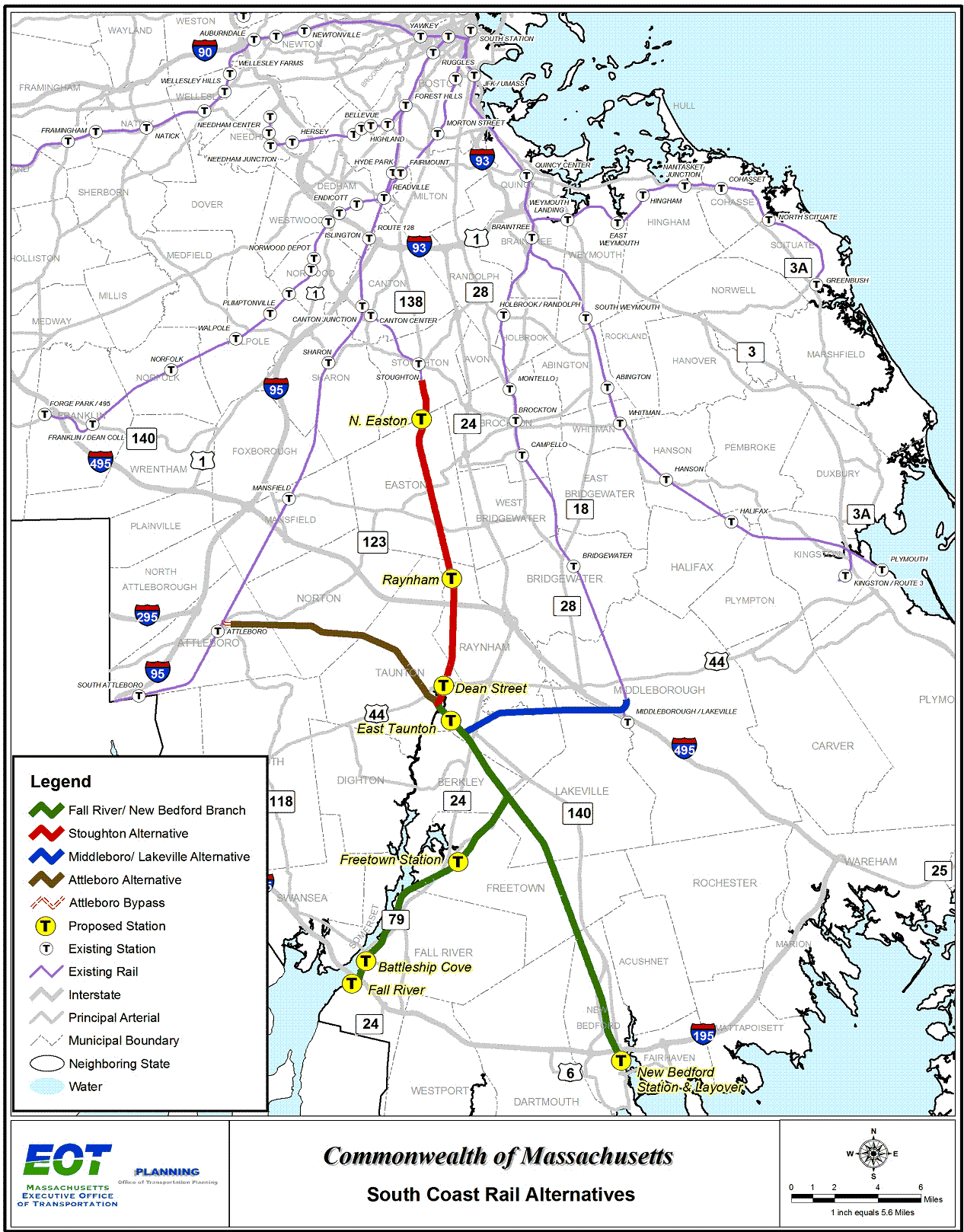Re: Fall River/New Bedford Commuter Rail
OK...for reference's sake, here's the least-worst options for re-creating a Providence-Fall River/Newport connection. Keep in mind that this is hopelessly expensive, fraught with EIS'ing uncertainty, and probably isn't going to float itself on demand unless City Hall gets demolished + the I-195 canyon gets reworked so the Wattupa Branch can get a side reservation opening up Providence-New Bedford service.
Yada-yada too many expensive moving parts...you get the pessimistic picture and bottom-line futility in it all.

All RI territory is de-landbanked existing ROW, and the new river crossing + hook-in to the Fall River Branch are on the footprint of the old ROW. Keep in mind that since MA 79 is going to be demolished for humongous TOD and park acreage between the NB and SB halves of Davol St. that the Fall River touchdown will be an unencroached nuke zone.
2 alternatives, both deviating off the Warren Branch ROW at the state line and crossing Wilbur Ave. to grab a very wide power line ROW. Our only saving grace here is that the whole area is THICK with power line ROW's thanks to Somerset Generating Station.
Alt. 1: Stick exclusively to power line ROW's (marked by double-ended arrows across map).
Advantages: 4.2 miles of contiguous land well-buffered from abutters. No private property takings. Easily acquirable from utility with no relocation of power lines. Straightest available path. Mostly level. Fastest track geometry. Accessible for construction via dirt access roads.
Disadvantages: 2 moderately large water crossings in Lee's River watershed w/ associated shoreline wetlands driving up cost. Couple adjacent residential subdivisions of possible NIMBY's. More EIS'ing unknowns throughout because power line ROW's aren't a pre-existing transportation corridor.
Alt. 2: I-195 median.
Advantages: All MassDOT land. Adequate median space. Sidesteps NIMBY pockets. Easier EIS'ing on 2 Lee's River watershed crossings by modding/augmenting existing 195 spans instead of building new.
Disadvantages: Lousy geometry, sharper curves, slower speeds. Warehouse property takings on Walker St. Close shave on Wilbur St. abutters. Complicated slip-on/slip-off to 195 median, with yucky wetlands impacts @ the Lee's River slip-on. Steel-and-concrete bridge construction costs over Lee's River same as Alt. 1, despite less-impactful EIS'ing. Caveat that highway median rail retrofits rarely pan out as simple in real life as the holy grail they look on-paper, so potential for unforeseen cost bloat.
The numbered placemarkers on the map show significant abutting structures or wetlands. Goes as follows:
1. Stony Creek Farm -- New ROW needs easement to split halves of property, needs farm grade crossing for tractors to access easterly field. Probably not a problem.
2. House -- Close shave of property lines, but no impact. Possible NIMBY.
3. House -- Slightly further away than #2. Possible NIMBY.
4. House -- Abuts power line ROW. No impact since now on ROW. Possible NIMBY. Other houses in neighborhood much better-buffered from power lines.
5. Wetlands -- Complication for EIS'ing Alt. 2 curve onto I-195 median. Curve geometry gets sharper, slower, more unfavorable the further away required to stay from riverbank.
6. Private easement -- Industrial abutter. Need easement through backlot. Not a problem.
7/8/9. Lee's River watershed crossings -- Perilous EIS'ing, expensive bridge construction. 8 & 9 could be one single structure instead of two.
10. Industrial abutter + 1 house -- Probably not long for this world once MA 79 comes down and Davol St.-facing redev becomes the motif for the waterfront. Expendable.
11. Bicentennial Park -- *Some* compromised access, but it already has two ugly electrical substations in the middle so being split by a rail viaduct wouldn't make it any less attractive.
12a-e I-195 overpasses/underpasses -- Lee's River watershed crossings would have to be doubled-up, median undercut on road overpasses.
13. I-195 slip-off -- Complicated because ROW has to diverge right at Brayton Point Rd. overpass. Reworking likely.
14. Residential abutters -- Not real close, but possible NIMBY's. Unclear if this meadow is wetlands.
15. Walker St. -- Splits industrial abutters; has to be taken for ROW. Land acquisition required, access disruption (but probably not outright demolition) to abutting buildings.
16-17. Multiple houses + businesses on Wilbur St. -- On old ROW, but zero buffer between backyards. Crappy low-income housing + auto chop shops, so NIMBY potential limited...but lots of properties affected by disruptive proximity.
There's probably no cost difference between the two. Alt. 1 has more EIS uncertainty, but much nicer track geometry if you can get it. Alt. 2 has shitty track geometry, but sure-thing EIS'ing. NIMBY problems not that significant because of sparse population density...more sorta close upper-class residential abutters in Alt. 1, bona fide land-takings and zero-buffer Wilbur Ave. abutters in Alt. 2. Pick your poison.
I kinda prefer Alt. 1 for being a flat-out better-performing rail route, and because I think pre-existing highway medians are a lot harder than they look to modify. The jump from the old ROW at the state line to the power line ROW is a turd-sandwich of a speed restriction, but it's unavoidable and at least gets its S-curving business over with quickly enough. But it's all moot because this just isn't a contiguous enough corridor to float its own demand, and will never be worth the money.
Oh, well...maybe in 2075 the demand picture will look different.





